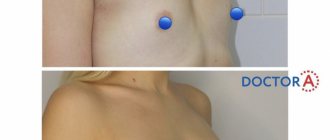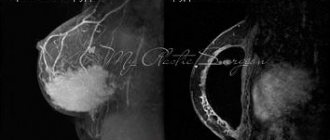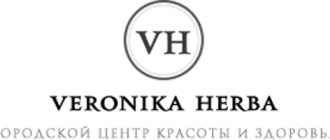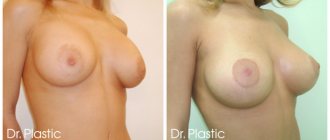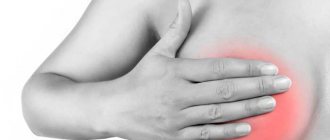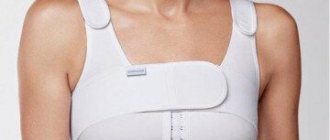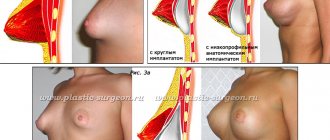Due to the fact that breast augmentation surgeries around the world are gaining popularity every year, women are keenly interested in the possibility of breastfeeding if they have implants. On the Internet you can find a wide variety of information on this issue - from bold and radical assurances about the complete safety of implants in relation to both the feeding process and the composition of mother's milk, to discouraging statements that implants cause almost catastrophic harm to the lactation process.
As a counterargument to statements similar to those described above, we note that the essence of the question is not so simple and cannot have a clear answer. First, let's look at a study conducted by Australian scientists in 2014, which proved that only one out of three mothers with breast implants, for one reason or another, does not breastfeed their baby.
During the year-long study, it was found that out of more than 300 thousand women giving birth, 892 had breast implants installed. As a result, 705 of them experienced absolutely no problems with breastfeeding and had a sufficient amount of milk. The remaining 184 women either did not feed at all or experienced difficulties with feeding. At the same time, among those women who did not have breast implants before giving birth, some also did not breastfeed or had problems with lactation. In percentage terms, it looked like this: out of 100% of women without breast implants, 89% did not experience any problems with feeding; among women with implants, 79% did not have any problems with feeding.
Meanwhile, the reasons why women (both with and without implants) did not feed their babies with breast milk were very different - microtraumas received as a result of mammoplasty, genetic disposition, diseases, as well as a simple reluctance to breastfeed in order to maintain breast shape.
Let's return to the question of the possibility of feeding in the presence of breast implants. It can be affected by a number of factors, including:
- type of operation performed;
- presence of damage in the milk ducts;
- the amount of functioning breast tissue present before and after the procedure.
Scar position and type of surgery performed
The location where the doctor made the incision to insert the implant will largely determine the degree of damage to the milk currents, nerve fibers and blood vessels. The most traumatic incision in this regard is around the nipple areola. The main advantage of this incision is that the scar will be securely “hidden” and will not be noticeable in the future. However, its disadvantage is that as a result, the sensitivity of the nipple may be temporarily impaired, since the nerve fibers that trigger the neurohormonal reflex necessary for the production and release of breast milk are damaged. In the vast majority of cases, nipple sensitivity returns, if not fully, then partially, but milk production may be impaired and milk may not be supplied in full. To maximize the preservation of the feeding function, it is better to use other surgical approaches - in the fold under the breast or in the armpit. These methods leave the glandular tissue and nerves intact and therefore have less impact on milk production.
In addition, both of these approaches reliably hide postoperative scars, and if we take into account that the quality of modern suture materials ensures better healing, then postoperative scars may not cause any concern at all.
Breast lift
Breast lift surgery, or mastopexy, may be necessary after rapid weight loss or pregnancy and breastfeeding.
Typically, such operations are performed using a technique that does not affect the gland and the area around the nipple. During the intervention, only excess stretched skin is removed, so there is no danger to further feeding.
Difficulties may arise if correction of the nipple areola is required - in this case, everything depends on the area where the ducts intersect. Be sure to warn the surgeon that you are planning pregnancy and breastfeeding.
Breast lift after breastfeeding is carried out no less than 3 months after the end of lactation. Then it becomes clear how much intervention will be required, and whether it will be necessary to combine mastopexy with the installation of implants.
Implant position and size
The size of the implant and where it is placed can also, although to a lesser extent, affect the amount of milk produced. However, this statement is still debatable, as it has not been confirmed by any rigorous research. There are only two possible options for the position of the implant - under the mammary gland and under the pectoral muscle. The position under the mammary gland can cause the implant to put pressure on the milk ducts, which can ultimately reduce milk production. While the position of the implant under the pectoral muscle, according to a number of surgeons, has less effect on production. However, these statements should be taken as the opinions of individual professionals only.
Not only the position, but also in many ways the size of the implant can affect future milk volumes. Everything is natural here - the larger the implant, the higher the pressure. This is especially important if a woman has implants that are much larger than her original volume.
How does pregnancy affect breast shape and size?
Due to hormonal changes in the body, natural sagging of the mammary glands may occur, and when milk appears, it increases in volume.
If a woman has undergone breast enlargement using large round implants, then the risk and degree of breast sagging during pregnancy is much higher. In such cases, very often after childbirth and lactation, subsequent corrective mammoplasty is required, which includes moving and fixing implants. When such a procedure is required, many women choose to have new, best-fitting silicone implants installed.
If the surgeon initially performed the operation so that the implants were well fixed, then their prolapse, especially if they are located axillary, is unlikely even after bearing a child.
Presence of scar tissue
Scar tissue itself is a complication after plastic surgery, since the tasks of the plastic surgeon, in particular, also include creating an invisible thin scar. In rare cases, due to improper scar care, medical errors or due to genetic disposition, the sutures can grow together, forming wide, unattractive scars. However, this can become not only an aesthetic problem, but also affect the entire lactation process. Scar tissue can cause firmness and pain in the breasts, cause breast deformation, and can also spread to the milk ducts, thereby affecting the flow of milk. Scarring is not a common complication, however, it cannot be completely excluded. If after surgery, instead of fading and disappearing, the scars begin to grow, then you need to contact your plastic surgeon as soon as possible so as not to start this process, but to prevent it as soon as possible. Moreover, in the arsenal of surgery today there are many ways to remove wide keloid scars.
Breast augmentation with gel
At the end of the last century, breasts were enlarged using biogel.
Due to various complications, it had to be removed frequently and today the gel is not used. It was replaced by injection products for breast correction based on hyaluronic acid. They are considered safe, and their administration is considered a cosmetic procedure. However, the use of such substances is not recommended for those who are planning pregnancy and breastfeeding in the next 2 years. The gel can compress the ducts, migrate, create conditions for inflammation and other problems. It is usually not necessary to remove it, as it resolves on its own.
Do not agree to such injections in home beauty salons: the price may be not only the ability to feed, but also your health.
Breast quantity
Often, women whose mammary glands are very underdeveloped and are almost in their infancy, akin to teenage ones, seek breast enlargement surgery. In such cases, difficulties with breastfeeding may be related directly to this, and not to the presence of implants in the breast. In addition, it is impossible to accurately predict how much milk a breast will produce even with obvious breast deficiency. A woman may as well experience absolutely no difficulties with feeding.
Small breast size in itself is not a risk factor for low milk production, but the same cannot be said for different breast shapes. For example, the risk is much higher in women with tubular breasts, excessively wide breasts (more than 4 cm) or asymmetrical breasts.
How are silicone implants used in plastic?
Plastic surgeons at SM-Clinic also work with French SEBBIN implants. Their production uses exclusively manual labor; implants can be made to order. There are no companies in the whole world that produce such a wide range of products in terms of size, shell texture, and filling. The company also provides a lifetime guarantee against breaks! The scope of application of silicone endoprostheses in plastic surgery is wide; we will consider ways to correct the body and face with their help.
- Bust reconstruction after mastectomy. In case of oncology, the breast is removed completely or partially. Installation of an endoprosthesis can be done simultaneously (during surgery to remove a cancerous tumor) or delayed (correction some time after a radical mastectomy).
- Mastopexy (breast lift)
. Endoprostheses are implanted when a woman wants to change not only the shape of her bust, but also its size. - Endoscopic breast augmentation
. This technology is needed when an incision is made in the armpit area, because in this case the implant can only be installed using optical instruments. The endoscope provides the surgeon with visual control over the manipulations. - Gluteoplasty – correction of the volume and shape of the buttocks. Special implants are used that will withstand a specific load - long sitting, running, sports. They have a dense shell and silicone filler. There is no need to change them over time.
- Curoplasty is a change in the shape of the calf area. Endoprostheses allow you to correct false curvature of the legs and replenish volume if the muscle layer is thin or hypotrophied.
- Facial contour correction, rejuvenation
. For this purpose, implants are produced in different sizes and shapes, they allow you to adjust the proportions of the face. They are used to highlight cheekbones, enlarge the chin and jaws, and smooth out areas under the eye sockets. Surgeons use facial prostheses made of hard silicone rubber. Typically, products with a thickness of 4 mm are installed, for a more expressive result - 5-6 mm. The product can also be made to order according to individual parameters.
Is it possible for damaged nerves and milk ducts to heal after surgery?
Yes. This is possible even with a periareolar surgical approach (when the scar is made around the nipple) - as a rule, most of the ducts and nerves heal quietly after the operation and function normally. Glandular tissue also develops under the influence of hormones that ensure lactation. This particularly helps to compensate for any damaged areas. For these reasons, it often happens that after breast augmentation surgery, the first child receives a slightly reduced volume of milk, and subsequent children receive an improved supply.
One way or another, even with the most extensive surgical interventions on the chest, some of the ducts and nerves will remain completely intact. It is very important to be frank with the plastic surgeon and let him understand whether the woman intends to give birth in the future and when the pregnancy is planned. Thus, the surgeon will exercise maximum caution when working with nerve fibers and milk currents and choose the most gentle type of operation so that the woman does not experience any difficulties with lactation in the future.
Is it possible to have mammoplasty during breastfeeding and pregnancy?
The answer is no. During this period, the mother’s body undergoes severe hormonal changes, so any surgical intervention is an extremely severe shock for the woman. Many patients decide to enlarge their bust about a year before the expected conception, or six months after the end of the lactation process. At this time, the mammary glands acquire their original shape and beautiful appearance, and they are also not so susceptible to hormonal changes. In this case, the healing process will not be too long.
Will implant material affect the quality of breast milk?
Most breast implants have a silicone shell filled with saline (salt water) or silicone gel (made from silicon). According to various estimates, about 70% of implants used today are filled with silicone gel, since, unlike saline implants, silicone implants hold their shape better, have excellent safety indicators and are simply more durable. Silicone is a synthetic substance, a mixture of silicon compounds (a natural element found in sand). Silicone is characterized by the lowest toxicity and is used in various fields - industry (insulating sealants), in medicine, and in everyday life.
According to recent research by scientists, the composition of milk in women without implants and with implants remains identical, so no obvious concerns have been identified at this time indicating that implants may have a detrimental effect on the quality of milk.
Summarizing all of the above, it is worth adding that breast augmentation surgery with implants has potential risks, and may ultimately affect milk production. However, these difficulties are only potential, and with the right approach from the surgeon and the woman herself taking care of her own breasts, she may not experience any difficulties at all and the feeding process will be calm and comfortable. It is also advisable, if a woman has implants and plans to breastfeed, to maintain constant contact with a lactation specialist.
You can learn more about breast plastic surgery in the “Breast Augmentation” section.
Breast augmentation using lipofilling
During the lipofilling process, your own fat cells are moved from one area (for example, buttocks) to the breasts. This is one of the safest correction methods. With its help, using your own resources, you can create more advanced forms in several problem areas at once.
The only drawback of such an increase may be that the result is not always predictable, since fat can migrate from the injection site or be absorbed.
Breastfeeding after lipofilling is no different from usual and no special preparation is required. But as is the case with any breast surgery, it is advisable that at least a year pass after the intervention.
Disadvantages of silicone implants, negative consequences of their installation
The disadvantages of such products are the following:
- the occurrence of capsular contracture;
- the likelihood of cracks, ruptures, and leakage of filler;
- the risk that the endoprosthesis will burst under high load (for example, when dropped on the chest);
- silicone provokes autoimmune diseases - systemic lupus erythematosus, vasculitis, rheumatoid arthritis, systemic sclerosis;
- decreased sensitivity of the bust, especially the nipples.
Possible complications:
- postoperative hematoma requiring surgical removal;
- impaired sensitivity when installing large endoprostheses;
- in the postoperative period – breast swelling due to the accumulation of fluid in the cavity of the product;
- bias;
- inflammation that requires urgent removal of the endoprosthesis (another one can be installed only after complete healing);
- gel migration over time;
- prolapse of implants, especially if they are large (in this case, after a certain period of time, you need to re-install other silicone implants).
